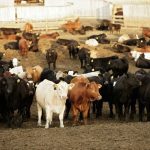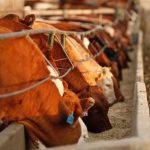Reading Time: 2 minutes For the week ending July 20, Western Canadian yearlings traded $8-$15 above prices from seven days earlier. Values for larger groups of quality calves were up $8 to $10 from a week earlier while run of the mill smaller packages were relatively unchanged.

Klassen: Feeder market leaps higher

Klassen: Buyers tasting feeder cattle prices for fall run
Reading Time: 2 minutes For the week ending July 2, Western Canadian yearling prices were steady to $5 higher compared to seven days earlier for larger packages. Small groups of 800-pound-plus cattle were $10 to $15 discounted to pen-sized lots. Calf markets were relatively unchanged from the prior week, although volume was limited. There is significant open demand for yearlings and finishing feedlot operators are watching how prices develop.

Klassen: Light volumes characterize feeder market
Reading Time: 2 minutes For the week ending June 29, Western Canadian yearling and calf markets were unchanged from seven days earlier. Many auction barns are in holiday mode and volumes were light, making the market hard to define. Late blooming stragglers and off grade calves were common.

Klassen: Canadian heifer retention tightening feeder supply
Reading Time: 2 minutes Alberta and Saskatchewan heifer placements in the lighter weight categories are down from year-ago levels. Comments from ranchers and order buyers suggest that Western Canadian ranchers are holding back on heifers to expand the herd. This usually results in a narrowing of the steer/heifer spread.

Klassen: Quality yearlings lead feeder complex higher
Reading Time: 2 minutes Western Canadian feeder cattle markets were quoted $5 lower to $5 higher on average in the week ending June 15. However, quality packages of yearlings traded $5 to as much as $10 above week-ago levels

Klassen: Feeder market hard to define on smaller volumes
Reading Time: 2 minutes For the week ending June 1, Western Canadian feeder cattle markets were relatively unchanged compared to the previous week. It’s that time of year when volumes are limited and the market can be quite variable from region to region.

Klassen: Demand for grass cattle pushes feeder market higher
Reading Time: 2 minutes In the week ending May 25, Western Canadian feeder cattle markets were trading $4 to $8 higher compared to seven days earlier. Some higher quality genetic packages of 700-pound plus cattle were up as much as $10 from week-ago levels.

Klassen: Demand for grass cattle pushes feeder market higher
Reading Time: 2 minutes For the week ending May 18, Western Canadian yearling markets were trading $3 to $5 higher compared to seven days earlier. Calf prices were relatively unchanged compared to the prior week. The feeder market appears to be consolidating near historical highs.

Klassen: Feeder cattle market takes defensive tone
Reading Time: 2 minutes It’s that time of year when available supplies start to decline. At the same time, demand is limited. Most backgrounding operators have sufficient numbers and demand for grassers is waning. Ontario interest was noted in Manitoba and Eastern Saskatchewan, which appeared to sustain prices near last week’s levels.

Klassen: Feeder cattle experience weather market
Reading Time: 2 minutes For the week ending May 4, Western Canadian feeder cattle prices were quite variable and the market was hard to define. Alberta and certain regions of Saskatchewan received snow, which caused the market to trade $3 to $5 lower. However, in Eastern Saskatchewan and Manitoba, feeder cattle prices were steady to $3 higher.


